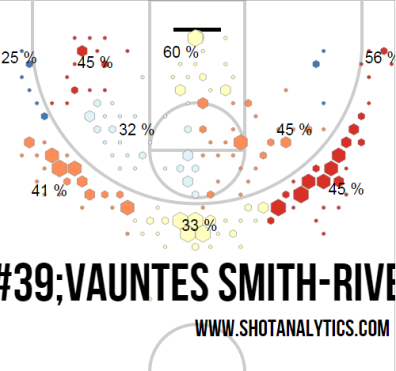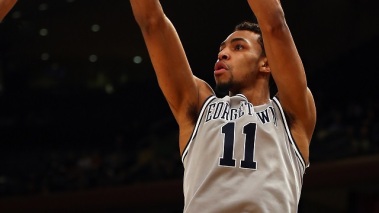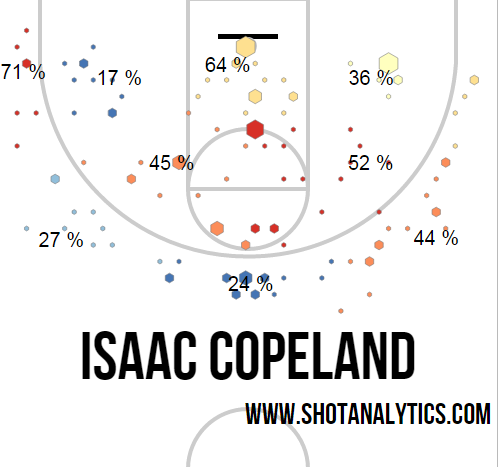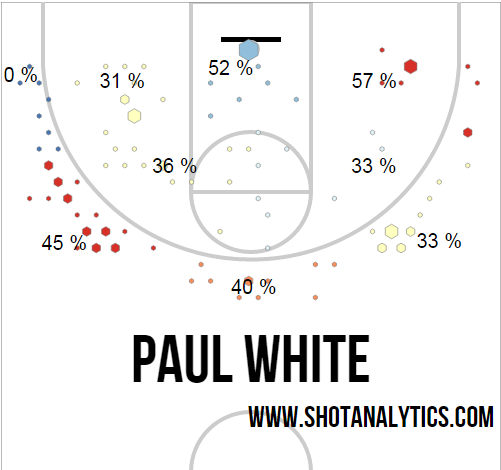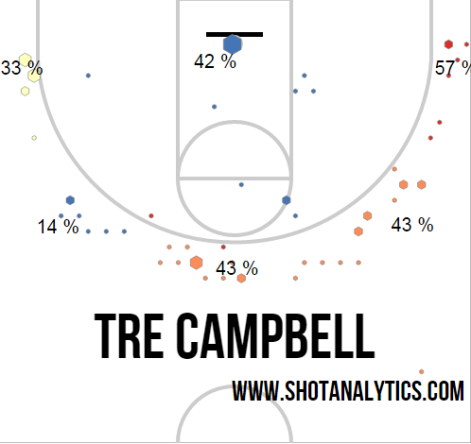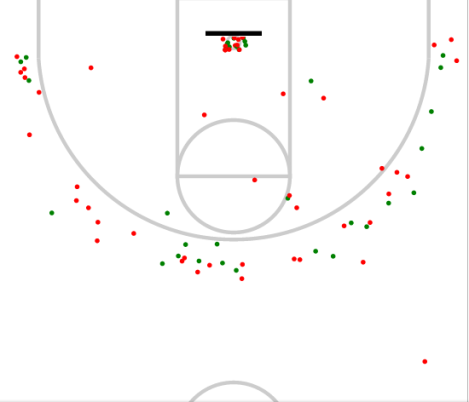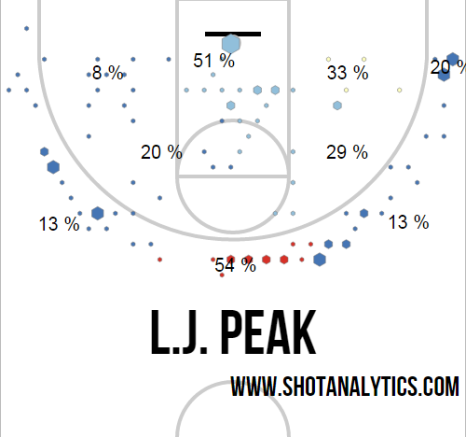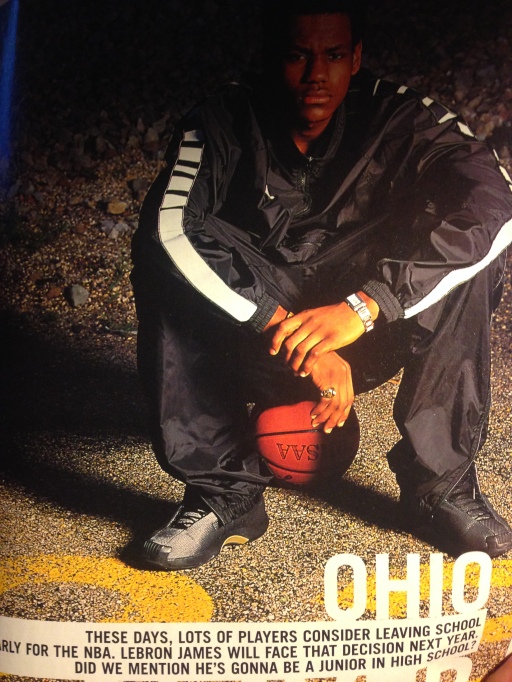Championship Contenders/Conference Champs: *I won’t be surprised if any of the following leave Houston in early April as the National Champs.
- North Carolina: Four starters back, and hard to single out anything as a weakness. Marcus Paige should be fully healthy and the interior combo of Brice Johnson and Kennedy Meeks is as good as it gets. Key: Can Justin Jackson make shots in March? Projected Offensive rating/Defensive rating: 117/95
- Kentucky: It’s a bet on talent and a pretty safe one given the last decade of Calipari coached teams. The three headed guard attack of Ulis/Briscoe/Murray should be dynamite. Key: Poythress does the dirty work. Projected O/D: 116/93
- Virginia: They gained experience last year playing without Justin Anderson and now have a utility group in Darius Thompson, Marial Shayok and Isaiah Wilkins to try to replace that production. One of the best starting back courts around with Perrantes and Brogdon. Not many better than Anthony Gill. Key: Small Forward production. Projected O/D: 113/91
- Kansas: Don’t bet against Bill Self in the regular season, and Self + Phog Allen’s home court advantage is enough to keep Kansas toward the top seed line again. KU has been a 1 or 2 seed 8 of the past 9 years. Deonte Graham should make a jump surrounded by high quality veterans. Key: Can Bragg and Ellis be big enough if Diallo isn’t cleared? Projected O/D: 112/92
- Oklahoma: Guard play, guard play, guard play. Woodard, Cousins and Hield are as good as any trio in the country. Hield is a NPOY candidate. Ryan Spangler is a solid interior presence. Key: Can Khadeem Lattin be a reliable full-time front court player? Projected O/D: 113/92
- Villanova: Experienced, well coached and should have one of the better true 5 men in the country in Daniel Ochefu. I’m not sure Kris Jenkins can guard other 4’s in space, so you could see Villanova revert back to small-ball centered around Ochefu with Brunson/Arc/Booth/Hart. Key: Can Brunson replace Hilliard’s production? Projected O/D: 114/96
- Wichita St: The back court is well known, VanVleet and Baker is an elite pairing. What may be going overlooked is the addition of 5th year senior Anton Grady from Cleveland State. Grady was a 14 and 8 player in 30 minutes last season and should be immediately productive for the Shockers. Key: Can anyone else step up on the frontline, Shaq Morris? Rashard Kelly? Projected O/D: 115/94
- Maryland: I don’t think they are quite the team people have made them out to be pre-season. There are question marks when you have a team full of different pieces from different places. Two high-profile transfers, a decorated FR looking to be one and done, a PG who turned down the NBA. Chemistry can’t be assumed. But there’s a lot of talent here, and at every spot. Trimble/Suliamon/Layman/Carter/Stone is as balanced in theory as you can have. And also possesses monster size. Key: Everyone falling into place. Projected O/D: 113/95
Regional Final/Final 4 Darkhorses: For one reason or another, I can’t view any of the following actually winning it all. But a strong season or a late March push is certainly in play.
- Duke: I’m likely in the minority here but I have major questions about point guard and on the interior. Coach K has obviously earned the trust that things will work out – and they likely will but I would be surprised if they repeated this year. I don’t think they planned for Tyus Jones to be one and done and now have an early enrolle at PG in Thornton, and if not him – someone less than fully comfortable in playing that spot. Interior questions are here, too. Brandon Ingram almost certainly will play a lot at the 4 spot to get the most talent on the floor. That only leaves small-framed Amile Jefferson or Plumlee 3.0 at the 5 spot. Key: Plumlee’s growth, Jefferson physically holding up. Projected O/D: 115/97
- Arizona: Arizona is a tricky bunch this year, if things go right – the talent is there to roll through the Pac 12 again. But a freshman who will take a lot of shots (Trier) coupled with two transfers (Anderson, Tollefsen) makes for an interesting dynamic. Kaleb Tarczewski is a main stay on the interior and Sean Miller should feel comfortable handing over the keys to Parker Jackson-Cartwright. Key: Tollefsen and Anderson successfully stretching the floor. Projected O/D: 112/92
- Louisville: I’ve seen a few folks down on Louisville this year and while the ongoing scandal doesn’t help – there’s a lot to like on the floor this year. Damion Lee is a big time player and Trey Lewis should prove to be one the better transfers in college basketball as well. Onuaku and Mathiang is an interior combo that is bursting with potential. And remember this: Rick Pitino has had a Top 5 defense in 7 of the last 9 years. Key: Quentin Snider’s development as a lead guard. Projected O/D: 108/89
- Notre Dame: There’s enough coming back year to partially offset the losses of Grant and Connnaughton. VJ Beachem and Bonzie Colson are both ready to make a leap and Demetrius Jackson looks like a bonafide All American candidate. Zach Auguste should continue to develop and be one of the better big men in the league. Key: VJ Beachem maximizing his potential. 6’8 with a 7’2 wingspan and a sweet looking shot. Projected O/D: 116/98
- Georgetown: There is bias here but hear me out. It’s been a while since JTIII can trot out 5 actual offensive threats with his hybrid Princeton offense. This is a versatile group with a plethora of 6-5 to 6’9 players who can switch in and out positions.The strong freshman class of last year should make significant improvements and DSR is around to lead the way again. Key: Jessie Govan’s conditioning. He has to able to play 25 good minutes. Projected O/D: 113/95
- Utah: The Utes lost do-it-all guard Delon Wright but return everyone else. While I don’t anticipate the jump most others are expecting from Poeltl, this figures to be a balanced group led by an exceptional coach. The defense will be stingy and there are enough shot makers to keep the offense afloat. Key: Finding someone who can make a play for a teammate. Projected O/D: 110/92
- Indiana: If you’re looking for a spaced floor and tons of points to follow, this is it. Indiana will play 4 out to go along with FR big man Thomas Bryant. The outside 4 of Yogi, Robert Johnson, Blackmon and Troy Williams is a dynamic group. All 4 can handle the ball and at least the first three (with Troy pending) can shoot it extremely well. Perhaps the best offense in the country. Key: Troy Williams’ decision making. Projected O/D: 117/92
- Gonzaga: Not as high as others on the Zags due to guard play. The security blanket of Pangos is gone as well as the steady hand of Gary Bell. The bigs are awesome but can you play more than two at a time? Key: Young guards getting up to speed. Projected O/D: 111/94
- Iowa St: Likely in the top tier had Fred Hoiberg not departed for the Bulls. Steve Prohm inherits a loaded roster with strong leaders in Niang and Morris. Jameel McKay likely figures to continue to grow as an interior force that ISU has not had lately. Key: Can defense improve? Projected O/D: 114/97
- Michigan St: The best shooting team that Tom Izzo has had in quite some time – even if his point guard can’t shoot a lick. Forbes, Harris and Valentine figure to start 2-4 and all are major threats from 3 point range. The trio of Costello, Schilling and FR Deyonta Davis have to replace what Branden Dawson left with (elite rebounding and defense), if they do..Izzo will be alive late in March again. Key: The bigs. Projected O/D: 111/95
- Michigan: If Indiana isn’t the best offense in the country, it could be a fellow B10 school. Walton/Levert/Dawkins/Irvin should be a devastating quartet on the offensive end given they stay healthy. This is the type of roster make up that Beilein will excel with. Key: Staying healthy, Ricky Doyle’s improvement. Projected O/D: 113/98
- Vanderbilt: Speaking of offense, Kevin Stallings should have his humming again in Nashville. Nearly everyone returns and elite shooting surrounds All SEC big man Damian Jones. The list of shooters from 3: LaChance (38%), Baldwin (44%), Fisher-Davis (41%) and Kornet (41%) – quite the group. The team posted an offensive rating of 113 last seasons and an already excellent mark will be improved on. Key: Perimeter defense and somebody helping Jones on the boards. Projected O/D: 115/99
Sweet 16 Caliber: This group should be solid throughout the year. Should set up shop in the 4-7 seed range.
- Baylor: Baylor will miss Kenny Cherry and the ability to play two point guards but the returning frontline should make up for any shortcomings. Prince, Gathers and Motley is a versatile trio with high-end athleticism. Gathers is perhaps the best rebounder inch-for-inch in the country and Prince garnered a lot of NBA buzz this summer. Key: Can Allerik Freeman be the secondary ballhandler the Bears need? Projected O/D: 110/94
- Miami: Four starters back and the addition of transfer Kamari Murphy sets up the ‘Canes for a solid season. Not many are better than Coach L and this team is to his liking. Multiple ball screens with a good host of shooters surrounding it. Jekiri provides one of the more reliable big men in the ACC, McClellan is one of the best two way guards nobody talks about. Key: Angel Rodriguez not being a hero. Projected O/D: 110/96
- Butler: The ‘Butler way’ should be spiced up a bit this year. Tyler Lewis, a senior Kellen Dunham and an improved Kelan Martin should provide Butler with more offensive punch than it has had in years past. Roosevelt Jones is still around to do Butler dirty-work. One concern is replacing the defense that Kameron Woods provided. Key: Martin turning from gunner to an efficient offensive weapon. Projected O/D: 107/93
- Syracuse: It feels as if everyone has fallen asleep on Syracuse after a down year and self-imposed post-season ban. Yet four starters return and there should be excitement around a freshman class headlined by Tyler Lydon and Franklin Howard. The defense should feature the traditional Syracuse length we’ve been accustomed to seeing. Key: Who is the point guard? DaJuan Coleman’s health. Projected O/D: 108/94
- Purdue: Matt Painter found his program’s identity again last year. Tough, physical with the ability to grind out games in the B10. There is a wealth of talent inside with Hammons, Swanigan and Haas – yet also the ability to play small with Vince Edwards at the 4. Key: Someone besides Kendall Stephens making shot. Projected O/D: 109/94
- SMU*: Not eligible for the post-season, SMU has on paper the quality of a Sweet 16 ball-club. You have to worry if next-town Brown isn’t overly motivated with the sanctions but he owes it to the returning group. Nic Moore and Markus Kennedy provides one of the better inside-out combos in the country. Key: Keith Frazier’s development. Projected O/D: 111/96
Low Ceiling, High Floor: Identities are in place. Players know their roles.
- Wisconsin: There’s a lot to replace here but Bo Ryan always finds a way. They’re going to be efficient, win nearly every home game and maximize whatever they have. Wash, rinse, repeat. Key: Ryan is still motivated. Projected O/D: 112/97
- Texas: With one exception here, I’m siding more with the talent remaining on the roster more than Shaka Smart being the force around a turnaround. He has a system and I’m not sure this roster fits it all that well. But, Smart is well…smart enough to at least adjust bits and pieces. Taylor, Ridley, Holland is a good trio to start with. Even with Myles Turner gone, they should defend the rim at a high level. Key: Taylor’s health. Projected O/D: 109/94
- Xavier: Chris Mack’s teams are always lurking in March. Even with losing their starting PG and hub of their offense in big man, Matt Stainbrook – it’s hard to bet against the Musketeers. A solid group of wings with improving big man Jalen Reynolds should produce a top four team in the Big East. Key: Someone grabbing hold of the PG spot. Projected O/D: 111/96
- San Diego State: They’ll suffocate you defensively and suffocate themselves on the other end. Can’t score and most nights don’t need to. The defense is elite and will remain that way. SDSU’s defense forced 18.6% of attempts to go beyond 30 seconds – the new shot clock should be a benefit to their team defense more than anyone. Key: Can Malik Pope make the jump? Projected O/D: 103/89
- Oregon: Oregon may not be able to replace what Joe Young gave them – but getting Tyler Dorsey and Dylan Ennis was a pretty good start. Those two will pair with a front-court of Brooks, Benjamin, Cook and Bell to give the Ducks a top six that is rock solid. Key: Dorsey carrying over his play from the summer. Projected O/D: 112/100
- Cincinnati: See SDSU. But one exception, there should be more offensive punch here with the duo of Gary Clark and Octavius Ellis inside. All 5 starters return, along with Mick Cronin. Projected O/D: 105/91
- Iowa: Iowa appears to be the forgotten member of the B10 this year. While Aaron White is a big loss, the return of Mike Gesell, Adam Woodbury and Jared Uthoff is a strong trio of upperclassmen. Iowa will likely deploy two quality ball-handlers at all times with Anthony Clemmons next to Gesell and Peter Jok may be in line for a breakout season. Key: Uthoff becoming an All B10 caliber player. Projected O/D: 110/96
- Providence: Kris Dunn slots the Friars here. With a player that good (the best, in my opinion), there’s only so many games that you won’t be in. He’ll keep them afloat on off nights and steal a game here or there they have no business winning. Ed Cooley can also coach ’em up, a common theme in this tier. Key: Rodney Bullock helping Ben Bentil inside. Projected O/D: 109/98
- West Virginia: Bob Huggins has a system in place now. After a few middling years, Huggins is going out on his own terms. Pressure and bodies in waves. I’ve seen few things in college basketball like last year’s Mountaineers. By far the leaders in forcing turnovers but a wretched defense if that wasn’t the case. They couldn’t shoot on the other end but hammered the boards. It feels like regardless of the names on the back, the name on the front has an identity now. Key: Replacing the playmaking of Staten. Projected O/D: 107/95
High Ceiling, Low Floor: You can’t give up on them until it’s over.
- LSU: There’s a very good chance Ben Simmons is one of the three best players in college basketball, if not the best. Antonio Blakeney is a high-level scoring guard and Tim Quarterman is a do-it-all 6’6 PG who is generating NBA talk. But, it’s hard to look at a team who just last season had two NBA forwards and stumbled to an 11-7 SEC record as being a sure thing. Johnny Jones leaves a lot of tactical work to be desired, but if Simmons has his supporting cast fall into place, watch out. Key: Can Elbert Robinson be a serviceable body for 15-20 minutes? Projected O/D: 110/96
- Cal: I’m not buying this, not yet. Cal has quite a bit of talent between Wallace, Bird, Rabb and Brown but it’s talent that Cuonzo Martin has never had – and I’m not sure his ability to coach offense will mesh well with a such a group. Wallace turned down the NBA and now has two McDonald AA’s that will want the ball, and numbers. Key: Putting Jaylen Brown in the right spots. He should be a stretch 4 for this team. Projected O/D: 109/97
- NC State: There’s likely a team in this group that struggles throughout the year but then things come together for a weekend in March and the year turns into a success. It feels like that team has been NC State for the last 4 seasons. Again boasting a talented roster, especially up front with Abdul Malik-Abu, Lennard Freeman and BJ Anya the Wolfpack should be improved defensively and protect the rim as well as anyone in the ACC. Key: Cat Barber’s keeps improving. It’s totally on his shoulders now with Trevor Lacey gone. Projected O/D: 111/98
- Uconn: 5th year grad transfers have been a blessing for a lot of college teams, and I would expect the same to be the case here for Uconn and Sterling Gibbs. It’s his back-court partner that I’ve never been high on. Rodney Purvis is likely to be pushed for playing time by Jalen Adams – and in an ideal scenario Adams moves Gibbs off the ball where he’s most comfortable. Daniel Hamilton has to refine his game but he Amida Brimah are NBA talents. Key: Another guard or wing who can make shots outside of Gibbs. Projected O/D: 108/96
- Florida St: A lot of bodies on the perimeter but a lot of talent, too. There’s a bit too much of a one-track mind with the Rathan-Mayes and Dwayne Bacon pairing for my liking – it may take a Montay Brandon or Terrance Mann upping their game to provide a necessary balance among the scorers. But there is plenty of talent and if Leonard Hamilton gets the ‘Noles defending near the level of some of his past teams, it’s a dangerous bunch. Key: Chemistry in the back court. Projected O/D: 110/97
- Texas A&M: I do not believe Anthony Collins is anyone’s answer to a point guard problem. But a strong freshman class coupled with the return of Danuel House could turn Texas A&M into a tough out late in the season. Key: Is House’s shooting from 3 sustainable? Projected O/D: 107/96
Likely a Year Away:
- Ohio State: Young but talented. No seniors and only one junior (Marc Loving). The Buckeyes will take their lumps this year but Thad Matta should keep the group competitive. JaQuan Lyle inherits D’Angelo Russell’s spot and JaSean Tate is an ultimate winner. Key: Grow up quickly. Projected O/D: 108/95
- Marquette: The trouble here is that ‘one year away’ may mean that there best player is gone. Henry Ellenson is a FR who should be in line to be selected in the lottery next June. He’s a 6’10 versatile forward who can play inside and out. He should put together an impressive FR campaign. The good news for Marquette is that there are no scholarship seniors on the roster. Wojo is laying the groundwork and a solid 2015-2016 season will provide a springboard into next year. For now, the bubble is probably where they end up. Key: Young guard play. Projected O/D: 106/96
- South Carolina: Slowly but surely, Frank Martin keeps chipping away. The Gamecocks have gone from 4 SEC wins to 5 to 6 in his first three seasons. There should be a greater jump this year as South Carolina emerged defensively last year, posting a defensive rating that was good enough for 26th nationally (94.3). With the addition of PJ Dozier and Sindarius Thornwell breaking out of his sophomore slump, the offense should experience an uptick as well. Almost there. Key: Thornwell shooting the ball to his ability. Projected O/D: 106/94
- Pitt: Pitt should be in the hunt for an NCAA bid this season again. Four starters return including SR point guard James Robinson and JR’s Jamel Artis and Mike Young. This is a bet on the latter two. Young and Artis should be one of the better tandems perhaps as early as this year, but if not – certainly in their SR seasons. Key: Fixing (even marginally) a dreadful defense. Adjusted O/D: 112/101
Mid Major Wreckers: The best bets to make it through the first weekend from the lower ranks.
- Boise St: Gone is perhaps the most under-appreciated player in college basketball, Derrick Marks. Returning are 3 other starters along with All-MWC performer Anthony Drmic from injury. As for Marks, there is a new point guard in Boise by the name of Paris Austin, and he won’t be a sleeper for long. James Webb is an NBA pick next June. Key: Austin’s transition to the college game. Projected O/D: 109/97
- Valpo: There’s a good chance Bryce Drew is linked to many of the top openings in college basketball next spring. Drew has made the NCAA Tournament twice in four years to go with a 49-17 Horizon league record. With a team full of starters returning from a narrow loss to Maryland in last year’s tournament, the Crusaders would be my best bet to advance a round or two this season from the mid major ranks. Key: Only poor health or bad luck in the conference tournament would disrupt a team on this pace. Projected O/D: 107/95
- Rhode Island: Dan Hurley has things rolling and this year should provide a breakthrough for the Rams. E.C Maththews is a top lead guard in all of college basketball. The Rams elite defense is centered around Hassan Martin – who despite his 6’7 height is one of the best shot blockers in the country. Key: In need of shooting, desperately. Projected O/D: 102/90
- Davidson: A team not in need of any additional shooting is Bob McKillop’s bunch. Four starters return to form a deadly offensive group. Jack Gibbs is no Steph Curry, but he may turn into the best thing Davidson has had since 2009. Key: Defending the interior. 298th in opponent 2PT % last year. Projected O/D: 114/102
- Utah St: Time will tell how the Utah State program maintains after the retirement of legend Stew Morrill, but the transition year should be a good one. Long time assistant Tim Duryea inherits a loaded Aggies squad with all 5 starters returning. Do everything forward Jalen Moore leads the way on a team sure to improve on last year’s 11-7 MWC record. Key: Defensive rebounding. A defense that was 52nd in opponent efG% finished 166th overall largely in part to second chances. Projected O/D: 108/100
